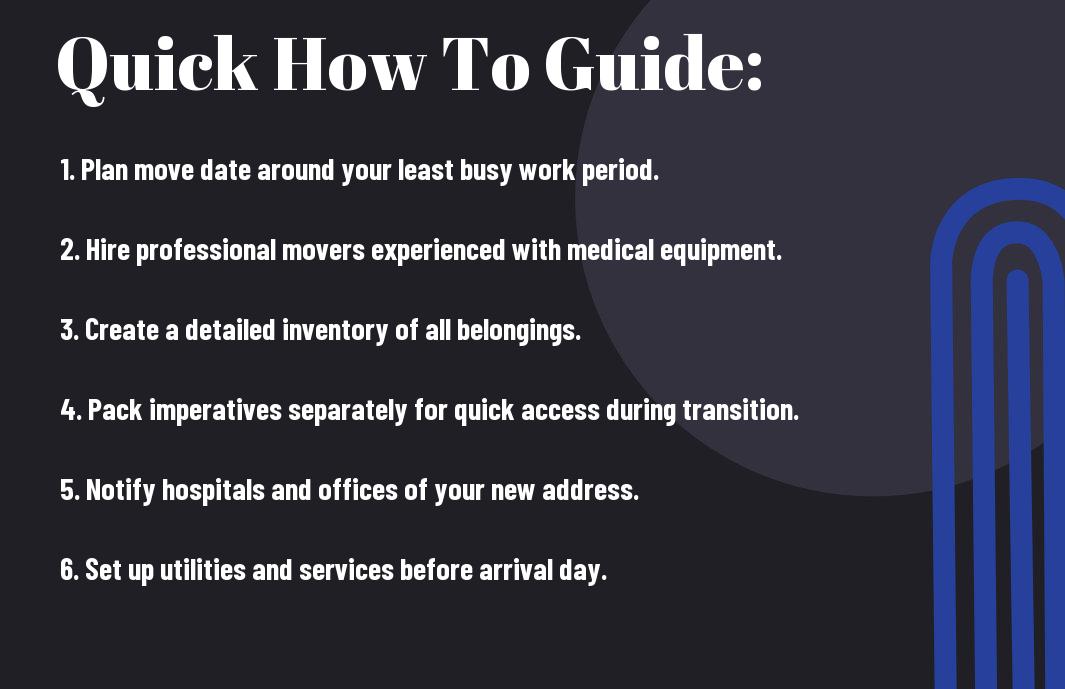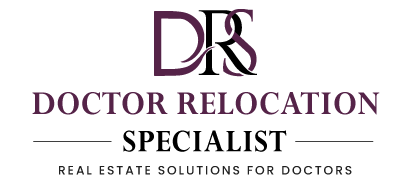Just as you prioritize patient care in your busy schedule, it’s necessary to handle your moving process with the same level of efficiency and organization. Transitioning to a new home can be overwhelming, especially for physicians managing demanding careers. This guide will provide you with practical tips and strategies to streamline your move, ensuring that your relocation is as smooth and stress-free as possible. Get ready to begin on this new chapter with ease and confidence, allowing you to focus on what truly matters—your practice and your patients.

The Unique Challenges Physicians Face When Moving
Relocating can be an overwhelming experience for any professional, but for physicians, the challenges multiply. The need to balance patient care, administrative duties, and personal commitments complicates their ability to focus on a seamless transition. As a busy healthcare provider, your time is limited, and the intricacies of moving must be carefully navigated to maintain both your professional responsibilities and personal well-being.
Time Constraints and Scheduling Conflicts
Your daily schedule can be packed with patient appointments, surgeries, and administrative duties, leaving little time for planning and executing a move. Coordinating logistics, from packing to hiring movers, often clashes with your professional commitments. This tight timeline can lead to stress and oversight, potentially affecting your transition and workload management.
Emotional Considerations: Leaving Patients and Colleagues
Transitioning to a new location can evoke a range of emotions, particularly as you prepare to say goodbye to patients and colleagues who have become integral parts of your professional life. The bonds formed with patients, built on trust and care, can make it difficult to leave, while colleagues may feel like family after years of collaboration. This emotional weight can sometimes overshadow the logistical aspects of moving.
Severing these relationships can be particularly challenging, as you’ve invested time and energy into fostering trust and rapport. The anxiety of leaving certain patients without a familiar hand could weigh heavily on your conscience, especially in situations requiring continuity of care. Engaging with your patients early about your move can help allow for a smoother transition and may provide closure for both you and them, transforming a difficult goodbye into an opportunity for growth and gratitude rather than anxiety and stress. Additionally, a farewell gathering or expression of appreciation for your colleagues can ease emotional burdens and provide a sense of closure, laying the groundwork for a positive transition ahead.
Strategic Planning: Setting the Foundation for a Smooth Move
Effective strategic planning is the cornerstone of a streamlined moving process. Prioritizing your tasks avoids last-minute chaos, ensuring that vital aspects are addressed early. By outlining your goals, key dates, and required resources, you lay a solid framework for each step of the transition, allowing you to manage your time efficiently amidst your busy schedule.
Creating a Comprehensive Moving Timeline
Drafting a detailed moving timeline involves mapping out all phases of the relocation process. Break down your move into manageable steps, allocating specific dates for each task, such as decluttering, packing, and scheduling movers. This timeline not only provides clarity but also helps you remain accountable for each stage, preventing oversights that could lead to stress.
Essential Checklist for a Hassle-Free Transition
An vital checklist organizes vital tasks that need attention during your move. Incorporate components like changing your address, transferring medical licenses, and notifying patients. This comprehensive approach ensures nothing is overlooked, and you can concentrate on your practice with peace of mind, knowing the moving details are handled efficiently.
Utilizing a checklist simplifies the transition process by allowing you to tick off items as they are completed, creating a sense of accomplishment. For physicians, specific items might include informing the hospital or clinic of your new location, arranging for your medical records to be transferred, and confirming insurance providers with your new practice. With critical tasks outlined, you can focus on your day-to-day responsibilities without disrupting patient care or compromising your professional obligations. Tailor your checklist according to your individual moving needs, ensuring it encompasses all aspects relevant to your unique situation.
Streamlining Logistics: Tools and Services That Save Time
Efficiency in logistics isn’t just beneficial; it’s vital for physicians navigating the time-consuming moving process. Utilizing dedicated moving services and modern technology can drastically reduce the time spent on logistical planning. Consider investing in moving apps that allow you to create checklists, track inventory, and communicate with your moving team. Incorporating services like packing assistance, storage options, or hybrid moving models where professionals handle heavy lifting can set you on the path to a more organized and less stressful transition.
Selecting the Right Moving Company for Your Needs
Your choice of a moving company can significantly impact your moving experience. Look for a company that specializes in medical professionals to understand your unique needs, such as flexible scheduling or handling delicate equipment. Seeking reviews and getting quotes from multiple companies will help you find the best fit. Specifically, verify their licensing and insurance to ensure peace of mind during the transition.
Organizing Essential Items for a Fast-Track Move
Efficiently organizing your vital items can simplify your transition and minimize downtime. Start by categorizing items as “vitals” and “non-vitals.” Pack your vital items—like medical documents, personal prescriptions, and vital technology—first, labeling boxes clearly to streamline access during the unpacking process. Allocate time before the move to do an inventory checklist that aids in both organizing and ensuring nothing important gets left behind. Keep critical items readily accessible in a separate bag or box for your first few days at the new location.
This strategic approach to organizing can save you hours of searching for critical items when you arrive at your new home. By prioritizing vitals, you allow yourself the luxury of unpacking at your own pace while instantly having everything necessary to continue your professional and personal life seamlessly. A well-structured organization plan not only reduces stress but also enhances your ability to settle into your new environment efficiently.
Balancing Professional and Personal Life During Your Transition
Juggling the demands of your thriving career with the logistic complexities of moving can feel overwhelming. Establishing a timeline to tackle each aspect of your relocation ensures a smoother transition. Reserve dedicated hours in your day for packing or appointments, allowing your professional responsibilities to continue without interruption. Keeping your personal life organized with a moving checklist helps reduce stress, enabling you to focus on both your patients and the adjustments you need to make during this challenging time.
Streamlining Patient Care Before the Move
As your move approaches, prioritizing patient care is necessary for a seamless transition. Communicate your impending relocation to your patients well in advance, allowing them ample time to adjust. Implementing a referral system and ensuring a smooth handover to a trusted colleague can help maintain continuity in care. Streamlining your schedule to focus on necessary appointments will also reduce last-minute chaos while ensuring that your patients receive the attention they deserve.
Maintaining Connections with Your Medical Network
Your relationships within the medical community serve as vital professional support. Keeping these connections alive during your transition can benefit your career and personal life. Regular check-ins with colleagues can foster collaboration, enabling you to exchange referrals and stay updated on best practices in your specialty. Consider joining local professional groups or online forums related to your field in your new area, ensuring you remain engaged with the community even after relocating.
Maintaining connections with your medical network is more than an idle social endeavor; it can significantly influence your professional growth. Engaging with colleagues before and after your move allows for the exchange of valuable resources, including referrals and guidance on local practices. Attending conferences or local medical associations in your new location not only strengthens these bonds but also broadens your professional horizons, ensuring you remain integrated within your specialty. These connections can provide support during your transition and foster collaboration, leading to enhanced opportunities as you settle into your new environment.

Embracing Your New Environment: Tips for a Quick Adjustment
Adjusting to a new environment can be both exciting and overwhelming. To facilitate a smoother transition, immerse yourself in the local culture and explore your neighborhood. Here are some tips to help you settle in:
- Familiarize yourself with local amenities such as grocery stores and pharmacies.
- Discover nearby parks or recreational facilities to unwind.
- Join local community groups or clubs to connect with residents.
- Explore dining options to sample regional cuisine.
After actively engaging in your new surroundings, you’ll find yourself feeling more at home in no time.
Engaging with New Patients and Community Resources
Building rapport with your new patient base can significantly enhance your professional satisfaction. Take the opportunity to participate in community health events, host informational workshops, or leverage social media to connect with patients. Local health fairs also provide a venue to showcase your practice while increasing patient awareness of available services.
Finding Support Within Your Local Medical Community
Establishing connections with fellow physicians is key to thriving in your new role. Reach out to local hospitals, attend medical conferences, or join professional organizations specific to your specialties. Engaging in networking dinners or events will further strengthen your integration into the local medical community.
Getting involved in your local medical community not only fosters professional relationships but provides valuable support. Collaborating with colleagues can lead to shared knowledge on best practices, referrals, and guidance on navigating unique challenges in your new area. By participating in local medical associations, you’ll stay informed about regional healthcare trends, create a network of peers for collaboration, and even gain mentors who can offer insight into patient care and community resources. Embrace these connections as you pave your path in this new chapter of your career.
Conclusion
From above, you can see how implementing efficient moving solutions can significantly ease your transition as a busy physician. By planning ahead, utilizing professional services, and prioritizing imperatives, you can ensure a smooth relocation that minimizes stress and disruption to your practice. Embracing these strategies will not only save you time but will also allow you to focus on what matters most—providing excellent care to your patients while settling into your new environment with ease.

